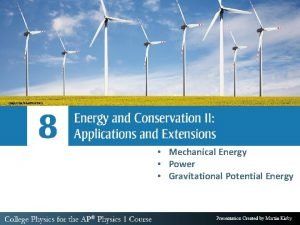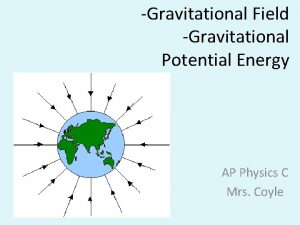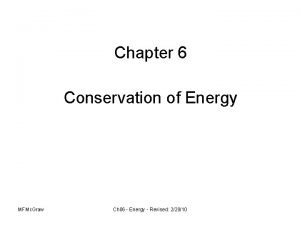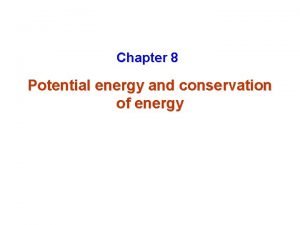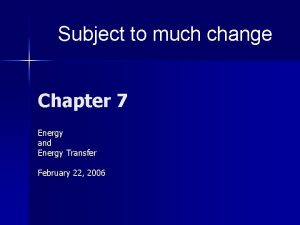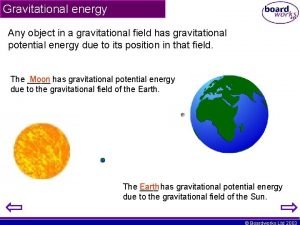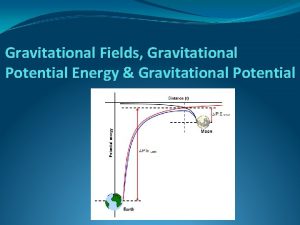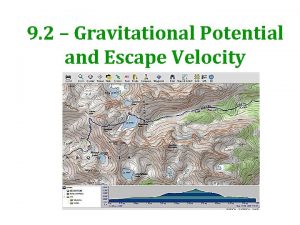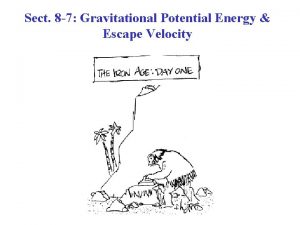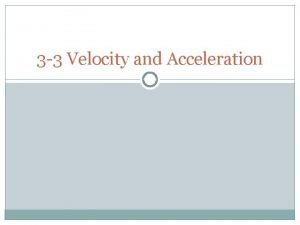Potential Energy and Escape Velocity Gravitational Potential Energy














- Slides: 14

Potential Energy and Escape Velocity

Gravitational Potential Energy We have already discussed gravitational potential energy. Ep = mgh However, as we have seen, g is not a constant but rather depends on mass of and distance to an object. Let’s Derive!!! g = Gravitational Field Strength Ep = Potential Energy Ep = - Gm 1 m 2 r

If you look at your formula sheet you will notice that this equation has a negative sign. What’s the deal? Whenever we talk about gravitational potential energy, we have to use a reference point. At this reference point we assign a gravitational potential energy of ZERO.

When determining the potential energy on a mass provided by the gravitational force generated by a second mass, we assign the ZERO reference point when the distance between the objects is infinite. This means whenever the objects get closer together the potential energy between them gets less. Compared to infinity the potential energy of the object will always be negative.

Let’s sketch a graph showing the relationship between gravitational potential energy of one object relative to another and the distances between their centers.

Example: A 2500 kg satellite is in orbit 3. 60 x 107 m above the Earth’s surface. What is the gravitational potential energy of the satellite due to the gravitational force caused by the Earth? Note: The potential energy of this satellite relative to some infinite position is negative!!

Example cont: What is the total energy of the satellite in the last question?


Example: How much work is required to move a 4500 kg Earth satellite from an orbital radius of 1. 8 x 107 m to a radius of 4. 2 x 107 m?

Example: The International Space Station drops a 250 kg waste shuttle from rest at an altitude of 3. 50 x 105 m. At what speed would it impact Earth if there were no air friction?

Example: A 2. 35 x 1016 kg asteroid falls towards the Earth from a really, REALLY far way away. How much energy is released when it impacts with the Earth?

Launching (Escape Velocity) What goes up must come down, unless we throw it really, REALLY hard. Escape velocity is the minimum speed an object requires in order to completely break free from Earth’s pull. It should stand to reason that if an object is going to be completely freed from the Earth’s gravitational pull that we need to supply it with enough kinetic energy to match its potential energy at infinite.


 Kinetic energy and gravity
Kinetic energy and gravity Gravitational potential energy vs kinetic energy
Gravitational potential energy vs kinetic energy Gravitational potential energy equation
Gravitational potential energy equation Gravitational potential energy
Gravitational potential energy Gravitational potential energy
Gravitational potential energy Expression for gravitational potential energy
Expression for gravitational potential energy What is potential energy
What is potential energy Electrical energy examples
Electrical energy examples Gpe= mgh
Gpe= mgh Thermal energy formula
Thermal energy formula Si unit of potential energy
Si unit of potential energy Elastic potential energy formula
Elastic potential energy formula Gpe formula rearrange
Gpe formula rearrange Potential energy
Potential energy Mgh formula
Mgh formula


